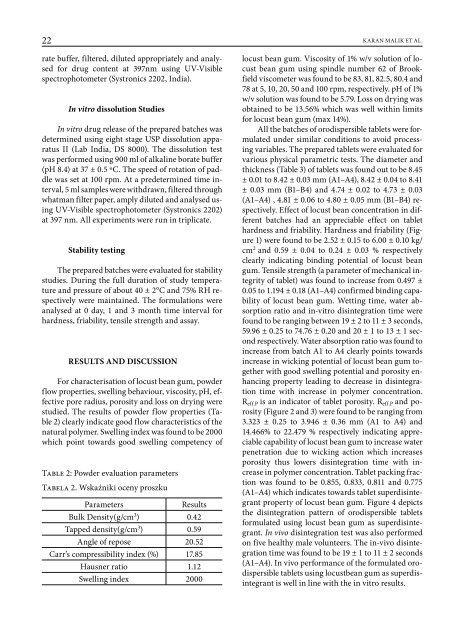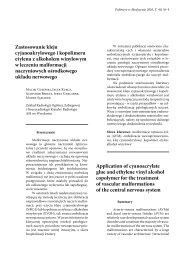Locust bean Gum as Superdisintegrant - Polimery w Medycynie
Locust bean Gum as Superdisintegrant - Polimery w Medycynie
Locust bean Gum as Superdisintegrant - Polimery w Medycynie
You also want an ePaper? Increase the reach of your titles
YUMPU automatically turns print PDFs into web optimized ePapers that Google loves.
22 KARAN MALIK et al.<br />
rate buffer, filtered, diluted appropriately and analysed<br />
for drug content at 397nm using UV-Visible<br />
spectrophotometer (Systronics 2202, India).<br />
In vitro dissolution Studies<br />
In vitro drug rele<strong>as</strong>e of the prepared batches w<strong>as</strong><br />
determined using eight stage USP dissolution apparatus<br />
II (Lab India, DS 8000). The dissolution test<br />
w<strong>as</strong> performed using 900 ml of alkaline borate buffer<br />
(pH 8.4) at 37 ± 0.5 ºC. The speed of rotation of paddle<br />
w<strong>as</strong> set at 100 rpm. At a predetermined time interval,<br />
5 ml samples were withdrawn, filtered through<br />
whatman filter paper, amply diluted and analysed using<br />
UV-Visible spectrophotometer (Systronics 2202)<br />
at 397 nm. All experiments were run in triplicate.<br />
Stability testing<br />
The prepared batches were evaluated for stability<br />
studies. During the full duration of study temperature<br />
and pressure of about 40 ± 2°C and 75% RH respectively<br />
were maintained. The formulations were<br />
analysed at 0 day, 1 and 3 month time interval for<br />
hardness, friability, tensile strength and <strong>as</strong>say.<br />
RESULTS AND DISCUSSION<br />
For characterisation of locust <strong>bean</strong> gum, powder<br />
flow properties, swelling behaviour, viscosity, pH, effective<br />
pore radius, porosity and loss on drying were<br />
studied. The results of powder flow properties (Table<br />
2) clearly indicate good flow characteristics of the<br />
natural polymer. Swelling index w<strong>as</strong> found to be 2000<br />
which point towards good swelling competency of<br />
Table 2: Powder evaluation parameters<br />
Tabela 2. Wskaźniki oceny proszku<br />
Parameters<br />
Results<br />
Bulk Density(g/cm 3 ) 0.42<br />
Tapped density(g/cm 3 ) 0.59<br />
Angle of repose 20.52<br />
Carr’s compressibility index (%) 17.85<br />
Hausner ratio 1.12<br />
Swelling index 2000<br />
locust <strong>bean</strong> gum. Viscosity of 1% w/v solution of locust<br />
<strong>bean</strong> gum using spindle number 62 of Brookfield<br />
viscometer w<strong>as</strong> found to be 83, 81, 82.5, 80.4 and<br />
78 at 5, 10, 20, 50 and 100 rpm, respectively. pH of 1%<br />
w/v solution w<strong>as</strong> found to be 5.79. Loss on drying w<strong>as</strong><br />
obtained to be 13.56% which w<strong>as</strong> well within limits<br />
for locust <strong>bean</strong> gum (max 14%).<br />
All the batches of orodispersible tablets were formulated<br />
under similar conditions to avoid processing<br />
variables. The prepared tablets were evaluated for<br />
various physical parametric tests. The diameter and<br />
thickness (Table 3) of tablets w<strong>as</strong> found out to be 8.45<br />
± 0.01 to 8.42 ± 0.03 mm (A1–A4), 8.42 ± 0.04 to 8.41<br />
± 0.03 mm (B1–B4) and 4.74 ± 0.02 to 4.73 ± 0.03<br />
(A1–A4) , 4.81 ± 0.06 to 4.80 ± 0.05 mm (B1–B4) respectively.<br />
Effect of locust <strong>bean</strong> concentration in different<br />
batches had an appreciable effect on tablet<br />
hardness and friability. Hardness and friability (Figure<br />
1) were found to be 2.52 ± 0.15 to 6.00 ± 0.10 kg/<br />
cm 2 and 0.59 ± 0.04 to 0.24 ± 0.03 % respectively<br />
clearly indicating binding potential of locust <strong>bean</strong><br />
gum. Tensile strength (a parameter of mechanical integrity<br />
of tablet) w<strong>as</strong> found to incre<strong>as</strong>e from 0.497 ±<br />
0.05 to 1.194 ± 0.18 (A1–A4) confirmed binding capability<br />
of locust <strong>bean</strong> gum. Wetting time, water absorption<br />
ratio and in-vitro disintegration time were<br />
found to be ranging between 19 ± 2 to 11 ± 3 seconds,<br />
59.96 ± 0.25 to 74.76 ± 0.20 and 20 ± 1 to 13 ± 1 second<br />
respectively. Water absorption ratio w<strong>as</strong> found to<br />
incre<strong>as</strong>e from batch A1 to A4 clearly points towards<br />
incre<strong>as</strong>e in wicking potential of locust <strong>bean</strong> gum together<br />
with good swelling potential and porosity enhancing<br />
property leading to decre<strong>as</strong>e in disintegration<br />
time with incre<strong>as</strong>e in polymer concentration.<br />
R eff.P is an indicator of tablet porosity. R eff.P and porosity<br />
(Figure 2 and 3) were found to be ranging from<br />
3.323 ± 0.25 to 3.946 ± 0.36 mm (A1 to A4) and<br />
14.466% to 22.479 % respectively indicating appreciable<br />
capability of locust <strong>bean</strong> gum to incre<strong>as</strong>e water<br />
penetration due to wicking action which incre<strong>as</strong>es<br />
porosity thus lowers disintegration time with incre<strong>as</strong>e<br />
in polymer concentration. Tablet packing fraction<br />
w<strong>as</strong> found to be 0.855, 0.833, 0.811 and 0.775<br />
(A1–A4) which indicates towards tablet superdisintegrant<br />
property of locust <strong>bean</strong> gum. Figure 4 depicts<br />
the disintegration pattern of orodispersible tablets<br />
formulated using locust <strong>bean</strong> gum <strong>as</strong> superdisintegrant.<br />
In vivo disintegration test w<strong>as</strong> also performed<br />
on five healthy male volunteers. The in-vivo disintegration<br />
time w<strong>as</strong> found to be 19 ± 1 to 11 ± 2 seconds<br />
(A1–A4). In vivo performance of the formulated orodispersible<br />
tablets using locust<strong>bean</strong> gum <strong>as</strong> superdisintegrant<br />
is well in line with the in vitro results.
















